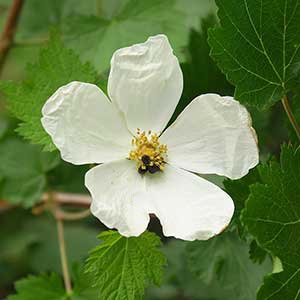Rubus bartonianus
Rubus canadensis
Barton's raspberry, bartonberry
Canadian or smooth highbush blackberry, ronce du Canada, smooth blackberry
erect, sparsely short-hairy, glabrescent, eglandular, not pruinose.
biennial, arching, glabrous, eglandular or sparsely sessile- to short-stipitate-glandular, not pruinose;
prickles absent or sparse, erect or slightly retrorse, slender, 2–5 mm, narrow- to broad-based.
deciduous, simple;
stipules lanceolate, 4–6 mm;
blade cordate to broadly ovate, (2–)2.5–4(–5) × (2.5–)3.5–4.5(–5.5) cm, base deeply cordate, 3–5-lobed, lobe apices acute to obtuse, margins coarsely doubly dentate, abaxial surfaces glabrous or sparsely hairy, eglandular or sparsely stipitate-glandular.
deciduous, usually palmately compound, lustrous;
stipules filiform to narrowly lanceolate, (5–)8–15(–22) mm;
leaflets (3–)5, terminal ovate to elliptic, (3–)7–9(–11) × (3–)4–5(–6) cm, base rounded to shallowly cordate, unlobed, margins finely to coarsely serrate or doubly serrate, apex acuminate to attenuate, abaxial surfaces sometimes with hooked prickles on midvein, glabrous or puberulent, eglandular.
1-flowered.
terminal on short shoots, sometimes appearing axillary, (5–)15–25-flowered, racemiform.
moderately hairy, eglandular or sparsely stipitate-glandular.
usually unarmed, hairy, eglandular or sparsely sessile- to short-stipitate-glandular.
bisexual;
petals white, obovate, (15–)20–25 mm;
filaments filiform;
ovaries glabrous, styles clavate, villous.
bisexual;
petals white, obovate to elliptic, 8–22 mm;
filaments filiform;
ovaries glabrous.
deep red, hemispheric, to 1 cm;
drupelets 10–30, coherent, separating from torus.
black, globose to short-cylindric, 1–2 cm;
drupelets 10–75, strongly coherent, separating with torus attached.
= 14, 21.
Rubus bartonianus
Rubus canadensis
Of conservation concern.
Rubus bartonianus is distinguished from the other flowering raspberries within its geographic range by its erect, unarmed stems, relatively small, simple leaves with acute to obtuse lobes, deeply cordate bases, sparsely hairy or glabrous abaxial surfaces, relatively large flowers with white petals, and densely long-hairy, clavate styles. The leaves superficially resemble those of Acer glabrum or some species of Ribes.
Rubus bartonianus is most similar to R. neomexicanus but especially R. deliciosus. The species is known only from the Snake River Canyon of Idaho and Oregon.
(Discussion copyrighted by Flora of North America; reprinted with permission.)
Rubus canadensis has a wide range and is the most northerly of all the highbush blackberries. The species is morphologically similar to R. allegheniensis except that the plants have little armature, are not as hairy, and have no glands. It also has characteristically lustrous leaves. The open and edge habitats in which it grows can greatly influence the phenotype, as with most highbush blackberries. At higher elevations or in poorer soil conditions, the plants are smaller; when partially shaded, leaves of primocanes may be larger. Leaves of floricanes vary in size and shape and are unreliable for identification. Because of the variation, multiple names have been erected, especially locally; it is felt that a stricter approach to defining it is prudent. Some of the names traditionally associated with sect. Canadenses (L. H. Bailey) L. H. Bailey are here associated with other Rubus species or are considered to refer to putative hybrids.
The following nothospecies names are based on putative hybrids involving Rubus canadensis and: R. allegheniensis (R. ×forestalis L. H. Bailey, R. ×immanis Ashe); R. flagellaris (R. ×lepagei L. H. Bailey, R. ×rixosus L. H. Bailey); R. hispidus (R. ×novanglicus L. H. Bailey); R. pensilvanicus (R. ×amabilis Blanchard [not Focke], R. ×amicalis Blanchard, R. ×elegantulus Blanchard [= R. canadensis var. elegantulus (Blanchard) Farwell], R. ×multilicius L. H. Bailey, R. ×noveboracus L. H. Bailey, R. ×pergratus Blanchard [= R. canadensis var. pergratus (Blanchard) L. H. Bailey], R. ×crux Ashe); R. setosus (R. ×miscix L. H. Bailey [based on R. ×peculiaris Blanchard (not R. peculiaris Sampaio)]).
(Discussion copyrighted by Flora of North America; reprinted with permission.)


